August 12 – 14, 2011
As soon as we exited the last of the flight locks in Ottawa and were floating free in the deep water of the Ottawa River, I breathed a sigh of relief. It felt so good to be aboard FLUKE and have her riding high and free once again with the wind blowing in my face, delivering the ride she was built for. Our Ottawa River run would take us 97 miles from Ottawa to Sainte-Anne-de-Bellevue, outside of Montreal.
After traveling about 30 miles, on the night of the 12th we anchored in a protected area off the river behind a little island. The peace and quiet of that environment were a welcomed contrast to where we had been tied to the wall with the hubbub of the city life in Ottawa.
The Ottawa River is up to 3 miles wide in some places and offers a variety of sights along the way. There are lots of farms, small villages, private homes, and marinas. On our port side, we could see the Chiliad hills of the Canadian Shield. Little villages were located from the base of the hills in the flat areas up to the bank of the river. Since it was the weekend, there was also a lot of recreational boaters traveling at high rates of speeds making a lot of wakes.
Bridges are at a minimum; most river crossings are made by taking a ferry. These are two big ferries, traveling between a couple of larger areas of populations. Where there were only two little villages on opposite sides of the river, there was only one small ferry, big enough for 3 or 4 cars.
We sure were surprised to see this big beach area along the river, the only one like it. While it's not exactly the French Riviera, at least it offers some fun in the sun during the too short summer months.
We decided we would try to find a marina where we could pump out the sewer. Most of the marinas listed in the cruising guides were too small to accommodate a boat FLUKE's size or didn't have enough water depth at the dock for us to pull up to. One marina had a big add listing all its services, including pump outs. Plus, we looked at the chart, and it seemed like it would have enough water at the dock.
It took a couple of tries on the radio to get someone at the marina and when a guy finally responded I told him what we needed and asked if he could take care of us. His English was actually pretty good, so I know he understood when I told him how big we were. As we got closer, I really began to have doubts about getting into the marina. The wind was blowing quite a bit, and all the boats, half the size of FLUKE were bouncing like crazy against their dock lines on the floating docks. Looking through the binoculars, I could see the guy on the dock, waving us in toward shore. A Canadian boat tried to cut us off, but the guy on the dock waved him off and called him on the radio and told him we were first. The Canadian gave us the evil boater eye.
Even though the dock looked too small for us, and we were stirring up a big mud storm from the water being too shallow, we kept heading in. Then I saw the pump out on the dock, and knew the guy had to be having some kind of pump out fantasy. It looked like he had carried it out in one hand. I told Eddie to take a look. He said it looked small enough to be used for a breast pump! With that information in hand, we said, thanks, but no thanks and headed back out on the river. At least we weren't in an emergency “full” sewer situation.
Our final destination for the day was the Carillon Lock, assuming there was room enough for us to tie up there. We had our doubts when we arrived at the blue line and saw how many boats were waiting to lock through. On second glance, we could see that most of them looked like day boaters anyway. Notice how boats tie up to the blue line wall, by attaching a line to that cable that runs horizontally across the wall. Since that wall is so high, most boaters can't reach its top, so a lower cable had to be supplied.
While Wayne and Eddie got off the boat to go check out the procedure for locking through since we had never locked through a lock like this before, I stayed aboard watched all the activities taking place. The people on the boat immediately in front of us, set up a grill and cooked hot dogs. Many other people knew each other and were hopping between boats. This standard poodle would sit outside and look around like you see in the photo, and then when he got too hot, he would run down below to get in the shade until he got tired of being alone and then would come out again.
So now you've seen both sides of this huge lock, lift 65'. The lock you see here was inaugurated in 1963 and replaced 3 canals with 11 other locks, some of which had been built as early as 1873. All the old locks were built for the timber trade, the principal industry for the whole region during that time. Between depleting the resource, and the development of railroad transportation, the locks had lost a lot of their importance for moving freight. Between 1959 and 1963 Hydro-Quebec constructed a huge dam and hydro-electric generating facility. As part of their project, the new Carillon lock and canal was constructed.
The gate weighs about 200 tons and is lifted vertically, you drive under it to exit the lock. While it only takes about 30 minutes to go through the lock cycle, it takes just as long to get all the boats safely tied up inside a chamber. So, you may have a two hour wait if you just miss getting in.
When it was finally time for boats to be put in the lock, the lockmaster yelled out loudly for “le bateau American” to come forward first. There was a clatter of voices going through the ranks, especially from many of those boats ahead of us who had waited much longer. People called on the radio wanting to know why FLUKE got to go first. The lockmaster is the king of the lock and sternly told them that, in this case, size really does matter, and the biggest boat needed to get in place first. We had to pull in fully forward, right in front of the massive gate.
Look along the right side of the boats. You can see a floating dock. That is what inside boats tie up to, and their position is aided by lock attendants (sitting under the cover on the dock). Once the inside boat is tied up, other boats come in the same row and tie off to the first boat. The floating dock goes and up down with the water level, making for a real easy lift. Remember Francois, Eddie's French friend from the Narrows, two weeks earlier? He showed up in his boat again, and tied off to us! 12 boats were in our lock through; everyone got in, so we didn't feel guilty about taking up so much space.
After we locked through, turned back around to face the water flow, we secured ourselves to the gray line area. Since the thunderstorms were forecast for the following day, we decided to also spend a second night at Carillon. There was plenty to do anyway, so we were happy to have a safe, interesting place to stay. One statistic says that 20,000 pleasure boaters and 30,000 canal bank users visit the facility each year. Since we are in the province of Quebec, everything is in French.
There are large park areas on both sides of the river, but you can't get to the other side of the river from the lock side by foot since they won't let you cut through the power plant and dam. You have to take a little ferry that runs between the two nearby small villages on either side of the river.
The lock side park has a memorial to the 1660 battle of Long-Sault, fought between a French explorer and the Iroquois Indians. Some of the original locks from the old canal days are still in place so people can see a comparison between the old and the new.
The pretty stone Collector's house has been converted into a little free museum and cafe, where you can buy, what else - creme de glacee, ice cream! The Collector was the person responsible for collecting the lock fees back in the commercial use days.
It was no easy feat for me to be able to sneak up to the thistle plant while several goldfinch were feeding on the seeds. We've seen flocks of them throughout the summer, but could never get close enough for a photo. I know, I still haven't posted the loon photo winner, but will in the near future.
This cement port-a-pottie was the first of its style we had ever seen. They seem to be pretty heavy, and I would have liked to have seen how they are transported, but no one came to maintain them while we were around.
The upstream side of the lock and dam is very exposed to the open river and land to the point where this sign had to be posted so people would have enough sense to be aware and tie up their boats properly, especially with the dam so close. This was the first time we have ever seen one of these signs.
Here you see Hydro-Quebec's huge hydro-electric generating station (1200') and spillway (800') stretching all the way across the river. There are 14 turbines which are termed run-of-the-river turbines, meaning they use the natural flow of the river to turn.
What none of the guidebooks tell you is you can take a free tour of the plant. We would have never known about it, except we were snooping around the base of the lock, where the power plant employees enter to go to the plant, and we saw a sign saying that you could use the phone supplied on the wall by the employee gate to sign up for a tour. You have to bring a picture ID, and no cameras, cell phones, or carry-in items are allowed.
We 3 FLUKESTERS were booked on a tour with 5 French people, so the tour guide had to try to do the tour in both languages, with French being her native tongue. Since we had read the brochures and placards, we could understand most of what she was trying to tell us. The tour is supposed to last 75 minutes, but obviously ours ran a bit longer, especially with me asking questions.
You start out the tour by seeing some videos about design and construction; for some reason the two videos were in English. Thank you. Then you go into a viewing area where there are some historical photos and several models about how the plant works. All very interesting and easy to follow.
You are required to wear a hard hat, safety glasses, and ear plugs before going into the power-generating portion of the plant. I wish we could have had our pics taken with our gear on – we all looked like real geeks, more than usual.
You walk on a level that is just above where the turbines are spinning, so you feel a lot of vibration and heat. Each turbine weighs 97.5 tons. This photo came from a brochure and gives you a good idea of size since you can see a man on one of the blades.
We were taken down a flight of stairs into a little room that housed one of the rotors, which are driven by the turbine below it to generate the electric current. It was 140 degrees in that area; the metal hand railing was uncomfortable to touch for very long. I think it was the hottest place I have ever been. We 3 all went together and took a good look at everything in the area. When the French group went in, they came out immediately, and I'm not even sure they went down all the steps. We could see they were really “fried”.
We cooled off quickly when the tour guide took us outside to where the transmission lines are located, overlooking the river. She explained how the overhead railway has a giant claw that is used to lift up debris that gets stuck in front of the intakes. She said they haul up everything, from log debris to dead animals of all kinds (deer, cows,) and even human bodies.
Visiting by water or land, it is worth the time to take the plant tour. That night, over dinner we were all talking about what a great time we had and how happy we were to have discovered the tour opportunity.
Checking email, we received a bulletin that the Rideau Canal between Jones Falls and the Narrows had fallen below the navigable 5' level. Good thing we got out of there when we did, just in the nick of time.
After we left Carillon we only had another 30 miles to go before we would reach the end of our Ottowa River adventure. This house attracted our attention, not only because it didn't look like it went in with any other home we saw on the river or even in Canada, but because of those palm trees. We didn't think they were real because they looked too similar to each other. Having them there is like us deciding to put a big hemlock in our front yard in Vero Beach, Florida. I don't think so!
We hoped to reach Sainte-Anne-de-Bellvue in time for our noon day feeding.
Thursday, September 08, 2011
Subscribe to:
Post Comments (Atom)
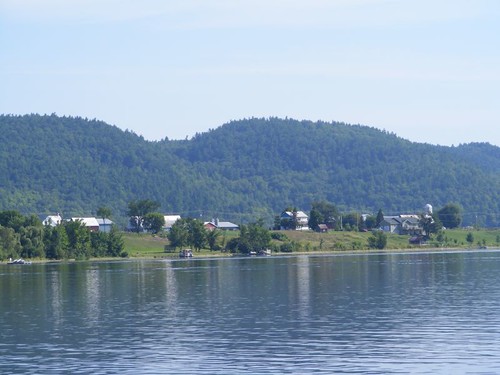
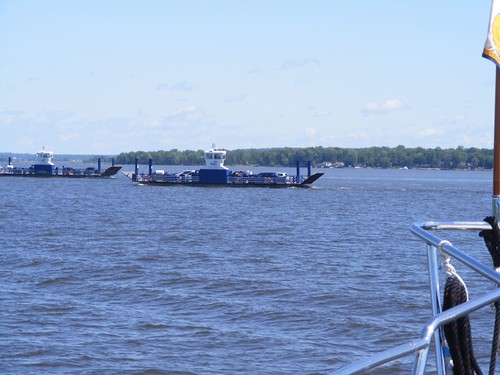
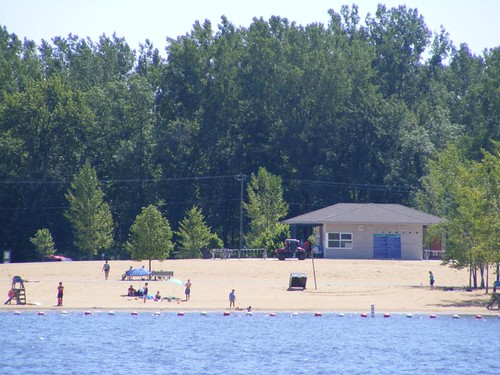
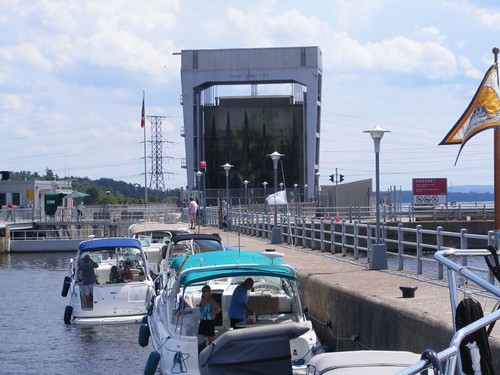

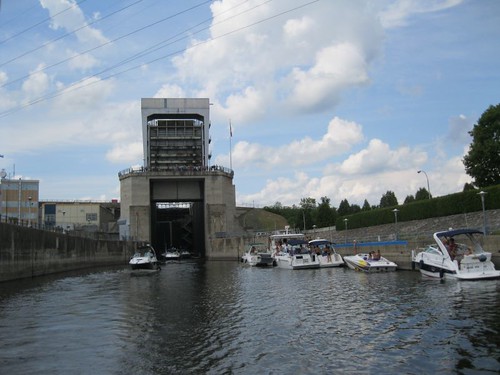
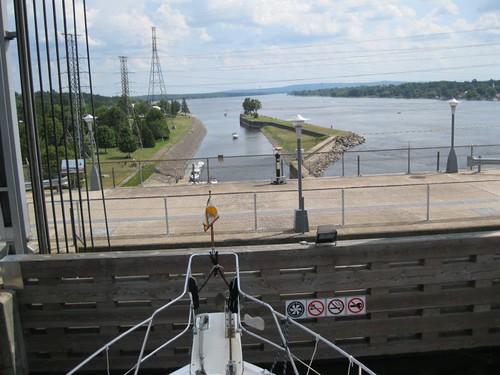
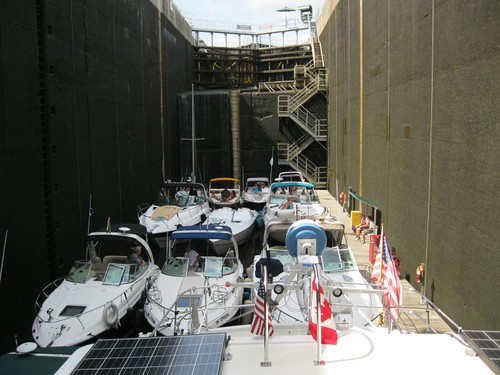
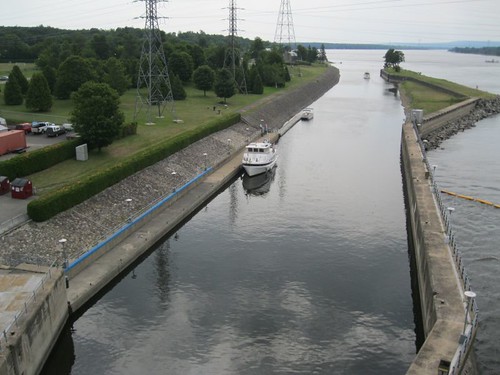
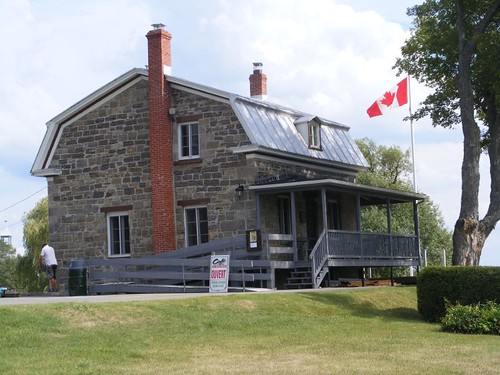

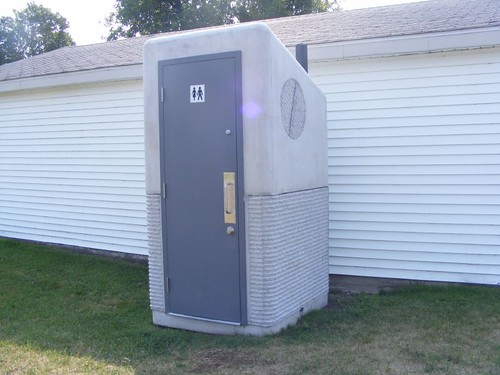

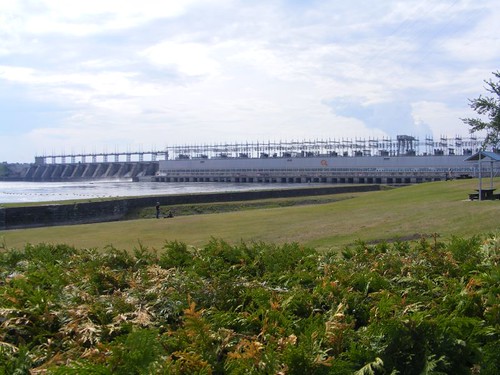

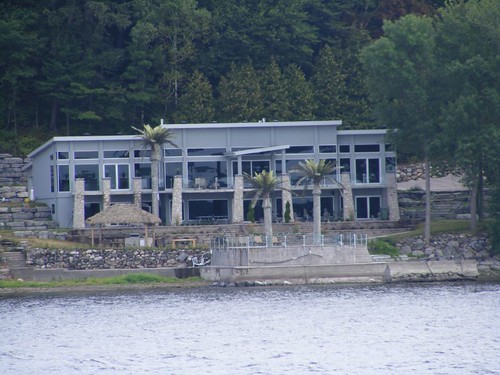








Enjoyed the hydro tour!
ReplyDeleteThanks!
Jerry